Youtube and the myth of Political Neutrality
- The political color of Youtube -

Youtube and the myth of Political Neutrality
- The political color of Youtube -

American electoral politics have been dominated by two major political parties: the Democratic Party and the Republican Party. While democrats are liberal and left-leaning, republicans adopted a conservative right-leaning ideology. Each year, the world watches how these two powerful parties dispute power and pick sides. In this context, does Youtube have a political preference? Does it pick a side of its own?
To answer this, we try to understand if and how YouTube aligns with the political phenomenon in the US. Through this analysis, we aim to shed light on the role that YouTube plays in shaping political views and the potential for bias on the platform.
YouTube is the world's largest video hosting service. In the recent years, Youtube audience grew more than 10 times: from 200 millions in 2010 to 2.5 billions in 2021. Such platform with a large user base has the potential to shape public discourse and influence the way people think about certain issues. If it is perceived as biased, it may only amplify certain viewpoints and silence others, leading to a distorted public discourse. Political bias can contribute to the polarization of society, as people are exposed to more one-sided views and may be less likely to engage with viewpoints that differ from their own.
Let's all listen to Donald Trump telling us all about the dangers of the Social Media Platform. Isn't it ironic that this is the exact tool he used to win the 2016 elections?
Thanks to YouNiverse dataset, we have access to youtube's content throughout the years. It contains a rich database of 72.9 millions videos, 136 thousands channels and 8.6 billions comment metadata we perform a deep dive into the topic.
First, we filter channels that have political content and are based in US, since the discussion is relevant for the US population. We perform a similar filtering on Youtube videos, only taken into account US videos from the News & Politics category.
We end up with 2,285,761 political videos and 8160 channels, after enriching our data with the help of Youtube Data API.
Using many different data analysis techniques (like real Data Scientists!) and external datasets, we are diving deep into the political world of YouTube.
For political affiliation labelling we trained a political-flavoured BERT model on Democrat Vs. Republican Tweets. We particularly used this dataset because we wanted our model to understand how people are expressing political ideas on social platforms (people talk differently online, aren't they?). We split the dataset into 80% train and 20% validation, obtaining an accuracy of 94.4%, so our model is pretty impressive.
Our model then analyses the concatenation between title and description to inpher wheter the video has Democratic orientation or Republican.
In order to deepen our understanding about the political phenomenom, we use a sentiment analysis model to label the sentiment of a video using videos' description and title.
In order to correctly label the setiment of each video we trained our political-flavoured BERT model on Twitter and Reddit Sentimental analysis Dataset. We used this dataset since we wanted to capture how people are expressing their emotions on social platforms.
Nowadays, everything is a continuous run for attention and affirmation, and Youtube is the right place for it. With a huge influence on the society, Youtube might be a powerful persuasive tool, which seems to make it the right one for politicians. Youtube's content reaches to hundreds and thousands of people every year. Thus, the more content a political party has the better chances to influence the audience has.
Which party has a better influence based on the above affirmation?
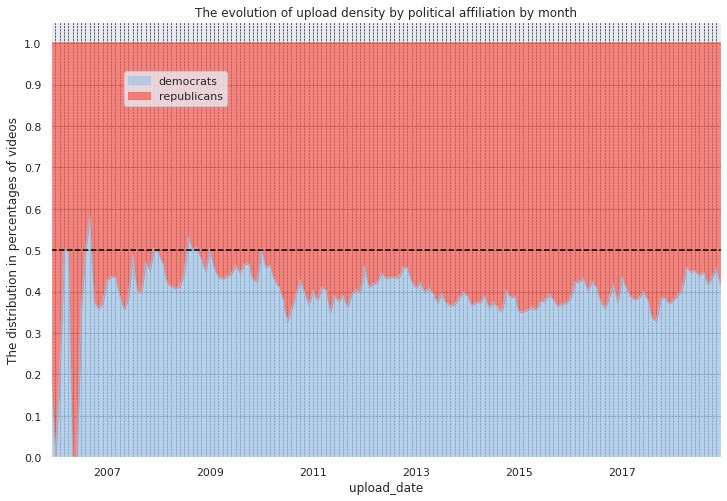
From the above plot we cannot conclude that throughout the years there is an overwhealming difference in the number of videos from both political spectrums. However, we can observe that there is a slight tendency towards more republican content posted each month. Since the quantity is our first metric, we can say that republicans have more influence, but this is only the starting point. However, we are not led by the premise that quantity is over quality, because Youtube is not about tons of content, but about likes and views.
In the pursuit of likes(votes), everyone would do anything. So do politicians.
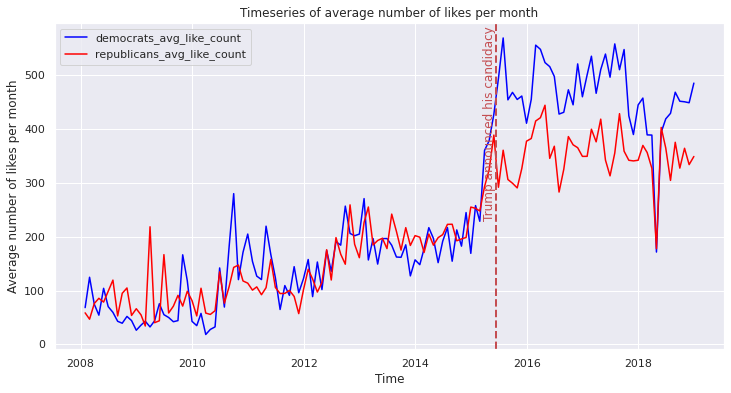
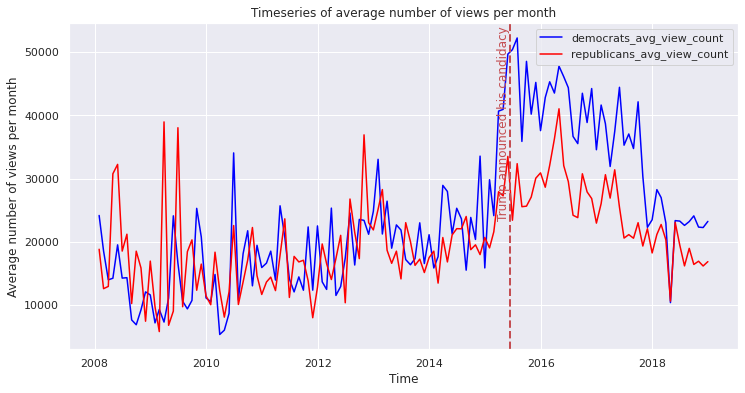
Even though there is more republican content, democrats have the power to gather definitely more engagement after Trump announces his candidacy for US president elections in June 2015, as we can observe from the likes. However, the pattern also can be observerd from the views. For this reason, we can conclude that quantity is not enough.
How open are politicians to technology? How well do they understand the power of social platforms and use them it within the larger context of their campaigns?
We analysed the extent of YouTube use as an election tool across parties for both House of Representatives and Senate candidates. We searched wheter or not each candidate has an official Youtube channel (we only considered Youtube verified accounts to be valid) at the time of the election.
When comparing the percentage of how many candidates within a party have a Youtube channel at the moment of the election, we can see that Democrats have a higher percentage of politicians with Youtube channel than Republicans. This stands true for every year between 2008 and 2018, for both Senate and House of Representatives elections.
We have seen that some politicians choose to use Youtube as an election tool while others don't. We take it one step further and try to predict the 2018 elections results for the Senate based on the popularity of the candidate Youtube Channel.
For each state, we check which one of the candidates has more youtube subscribers one week before the election. We predict that this politician will be the winner of the election. However, if the politician don't both have a Youtube account, we predict as the winner the politician that has a Youtube channel. If neither of the candidates have a valid Youtube channel, we don't have enough data to make a prediction.
AMAZING! It seems that looking at the Youtube Channel, we can predict with an extremely high accuracy the outcome of the elections, where data is available. And this is not just true for the 2018 elections: the method can be successfully applied to 2016 elections as well. Multiple explanations are possible for this: Youtube might only reflect the popularity of the candidate, since it has a bigger electorate, thus more people interested in their actions, stronger politicians with an overall better-financed campaign might have bigger budget to invest in their promoting, resulting in a better mentained Youtube channel.
Do democrats and republicans live in partisan bubbles or is there any conversation between the two sides?
In order to answer this question, we will analyze the how users interract through commented videos. We connect the videos that were commented by the same user. The weight between each pair of video indicates how many users commented under the same video. In this way, we can see wheter or not videos form a community of similiar topics and engagement using community detection algorithms.
We ran a community detection algorithm based on The Louvain Method to produce clusters showing users engagement under videos. We observe dense regions in graph that indicate which content were engaged by users. Let's use previously described video labels see how many videos related to each political spectrum are in each clusters.
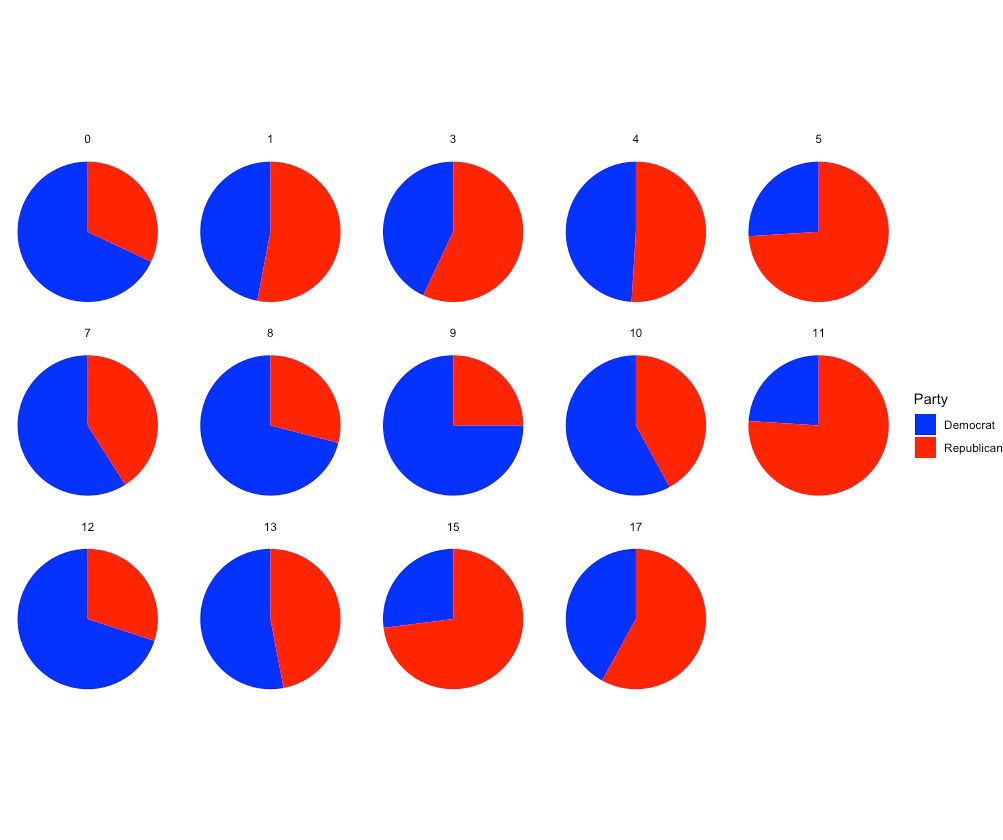
We can see that there are clusters that contain videos mostly related to a single political spectrum, and there are a few which seem to be ballanced. This suggests that while there are some communities that are willing to listen to pros and cons of both sides, there are also communities prone to the ‘echo chamber’ effect – in which people seem to spend most of their time watching ‘like-minded’ content.
In order to get some sense of what clusters are about, we ran a Latent Dirichlet Allocation (LDA) topic detection algorithm in order to get some sense of what clusters are about. LDA assumes that each document is a mixture of a small number of latent topics, and that each word in the document is generated from one of the topics. We have found that using a video's description as a input to the model does not produce meaningful topics, because videos' description is often filled with hyperlinks or repeatable content. Thus we use video's title as a main source for extracting topics.
For each cluster we manually inspect produced terms and get a sense of their content. Let's investigate some of them. The results are fascinating...
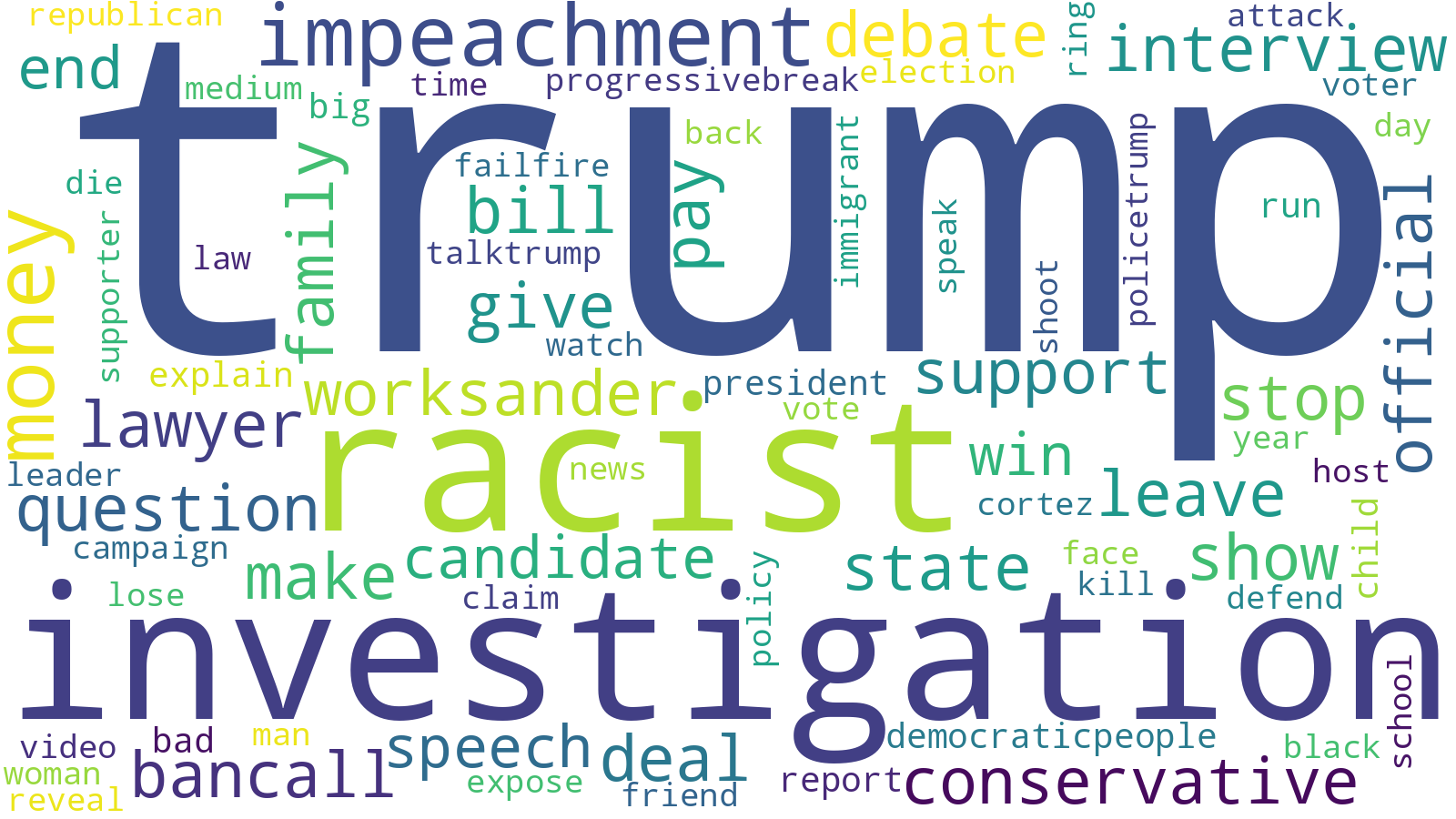
This cluster contains many terms connected to the Donald Trump. Many of them seem negative. This suggests that this cluster might contain videos disliking Donald Trump.
Let's investigate the number of negative sentimental videos from the time when Trump announced his presidencial candidacy.
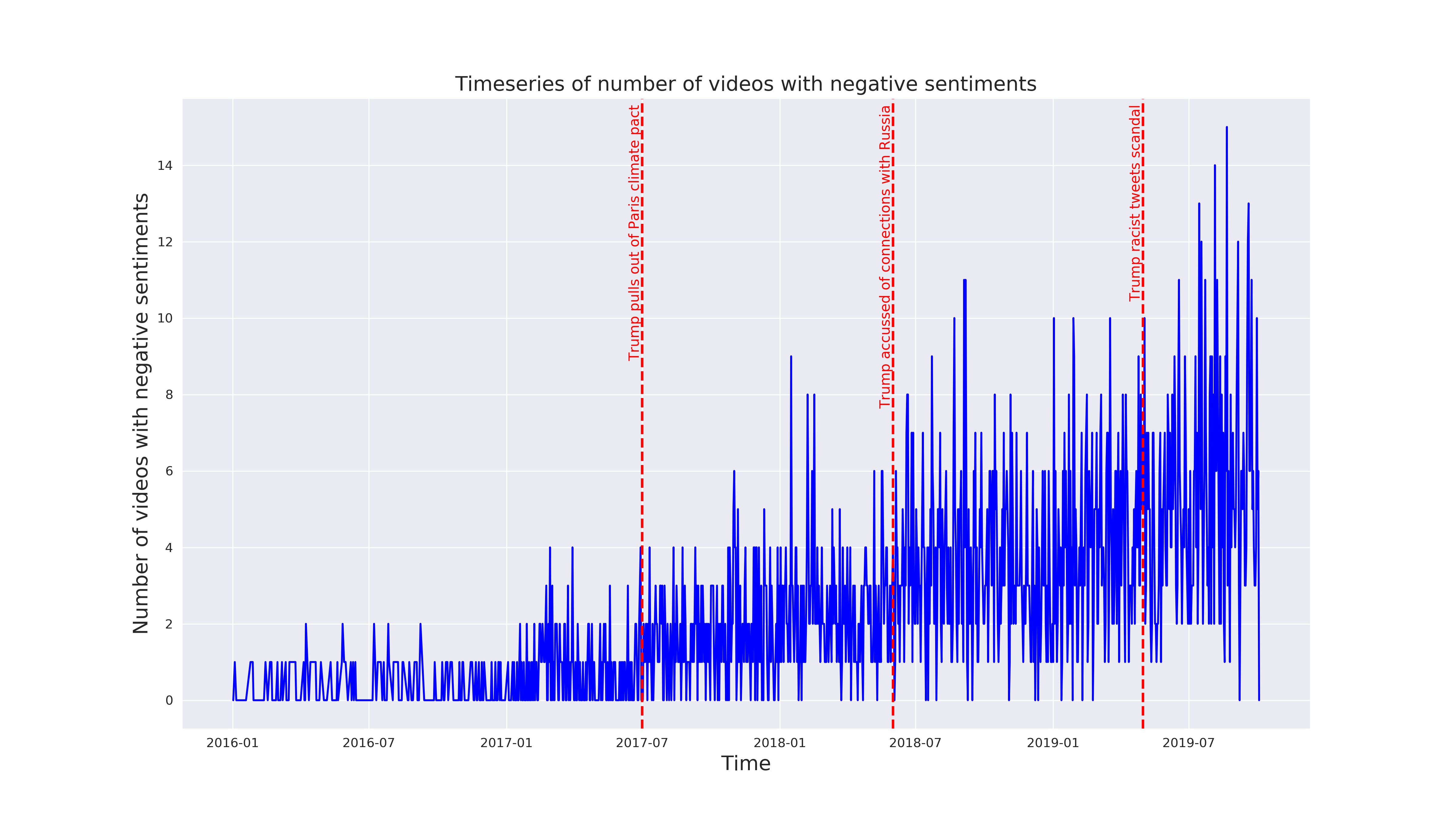
We can indeed see that this cluster contains many videos that were published during political scandalds around Trump. On the visualization we can also see dense regions on graph with more engagement. Red and blue node colors refer to the video labeled to democratic and republican spectrum respectively.
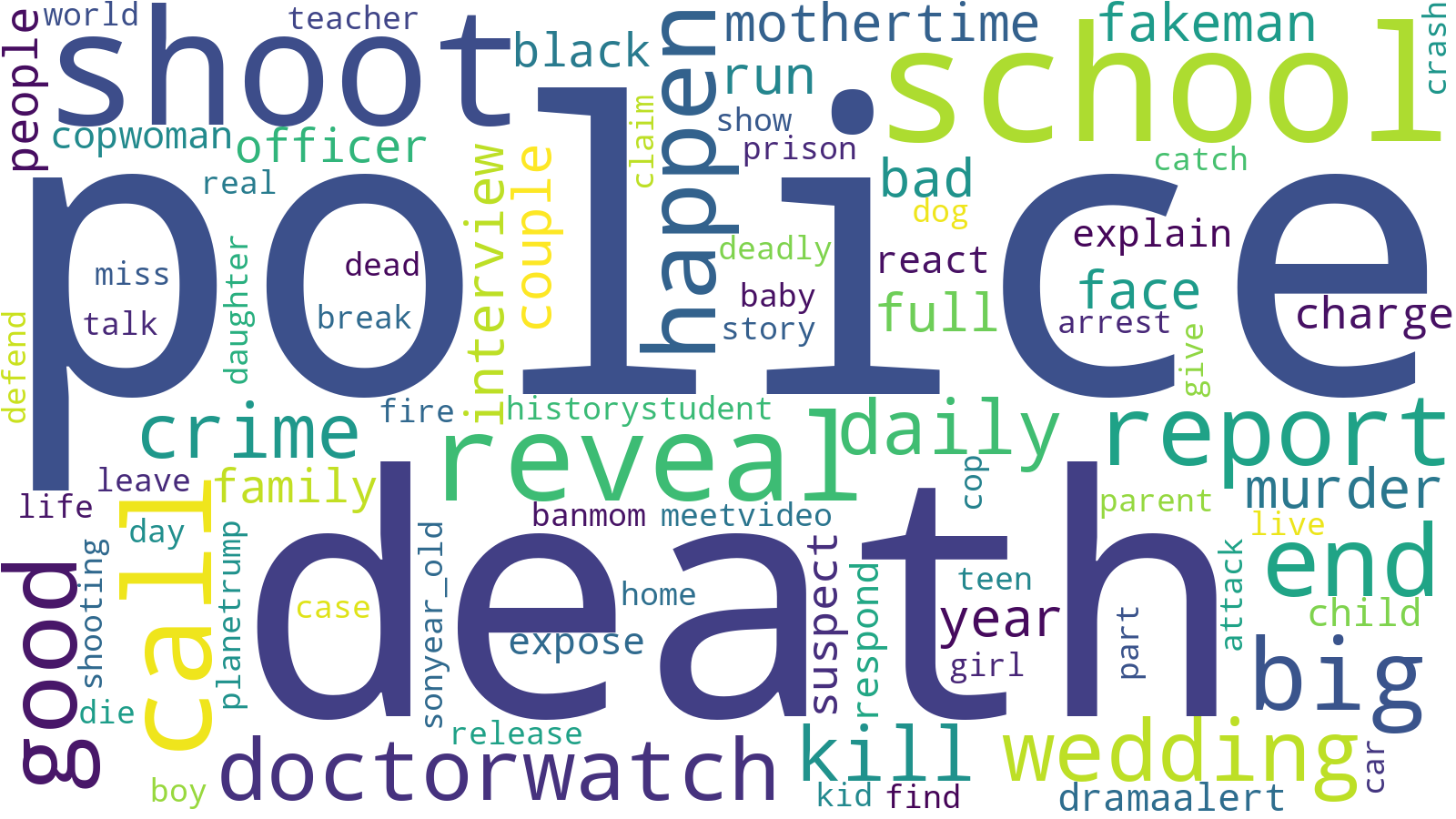
This cluster proofs hypothesis that there exist topics that are raised by both political spectrum media. Problem of gun violence in America is especialy given attention by media when it happens during major social events or around educational institutions. By looking at above results we can conclude that videos revolving around this topic, such as gun control debates, are given attention by both political spectrum media.